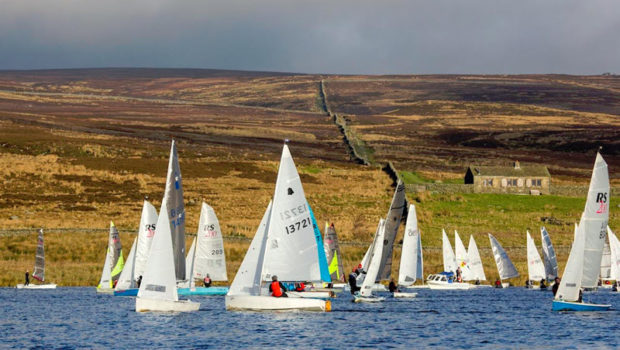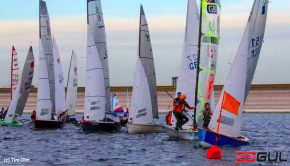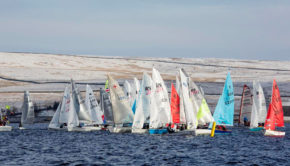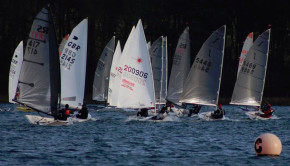Embracing Dinghy Handicap Racing
Published on March 16th, 2017
While the concept of racing dinghies under a handicap system may be a rarity in North America, the highly successful GJW Direct SailJuice Winter Series in the United Kingdom should give thought to the idea. Having just completed its eighth season, Andy Rice shares what is making this format work.
Why is it that some of the country’s best dinghy sailors bother to race in the GJW Direct Sailjuice Winter Series? After all, who cares about handicap racing compared with the one-design championships of the summer? There’s no arguing the weather is better in the warm half of the year, but for a growing number of sailors, the pull of winter handicap events is proving irresistible.
Matt Mee is a former Fireball World Champion and a former member of the Olympic squad when he campaigned a 470 before deciding to get a proper job. Now he races an RS200 with his girlfriend Emma Norris. They sailed a very consistent set of races to win the 7-event series.
Over the years the Series has consistently attracted the highest calibre sailors such as Nick Craig, the all-time Endeavour Champion (ie, Championship of Champions) record holder who won this winter circuit two seasons ago in a Merlin Rocket. In fact most of the Series winners over the past eight years have won major championships at some point in their careers.
Craig makes no bones about the fact that he wasn’t that bothered about winning the Series in itself. For the multiple champion, it was all about keeping his eye in over the winter with some tight, tactical racing.
It’s a different type of racing compared with one-design competition where the game is all about beating the opposition on the water, maybe giving away time and distance to defend a lead. In handicap racing, you’re up against the clock, so the tactics are different. It’s about keeping clear air, keeping the boat moving, and avoiding the pinch points around the course. Avoiding the congestion zone.
Does that make the winter handicap racing scene irrelevant to being successful on a one-design racing circuit during the summer, when maybe the courses are straightforward windward/leewards? Not at all, if you believe the view of some sports psychologists. Cross training helps broaden your skills and prepares you better to cope with the unexpected.
Why would you want to practise tight-reaching if your championships are only ever contested on windward-leeward courses? Well, what about if the wind changes direction? In an overpowered singlehanded asymmetric dinghy like the Musto Skiff, this can turn the boat into a real handful, but for regulars on the GJW Direct Sailjuice Winter Series like Ben Schooling (this year’s runner-up), he’s been practising that move all throughout the off-season. On those days during a class championship when the wind turns and you find yourself below the layline for the gate, Schooling knows what to do.
Training and honing your skills might be one reason why you might want to race in the Series, but for most it’s a simple matter of it being good fun. “I’ve made so many friends from other classes that I’d never normally meet,” says Russ Clark who with wife Penny won the last event in their RS400 at the Oxford Blue. “It’s great to remind yourself of what else is out there in the dinghy world, to see boats you might never otherwise see, like the National 18.”
Some are even finding that they’re starting to enjoy the organised chaos and traffic jams of a big handicap fleet compared with the more predictable ebb and flow of one-design racing. The racing is hectic, there’s still a large dose of luck required for success, but getting in amongst a whole array of boats that might range in speed from the Topper through to a foiling Moth is an experience that can start to get addictive.
With 10 different classes in the top 10 overall, and quite often nine or 10 different types of boat finishing in the top order of individual events, it’s possible to win in pretty much any kind of boat. That’s all thanks to the members of the Great Lakes handicapping group chaired by Andrew Craig from Queen Mary Sailing Club.
Where past winters have tended to be windy and played in favour of the trapeze boats like Fireballs and 505s, the lighter winds of this recent winter have seen some of the hiking boats come to the fore, such as the RS200 and RS400. Over the 2016/17 season, a total of 1012 competitors representing 89 different classes competed in the Series.
THE EVENTS
The following regattas constituted the GJW Direct SailJuice Winter Series 2016/2017:
• Draycote Dash, Draycote Water Sailing Club, Nov 19-20
• Datchet Flyer, Datchet Water Sailing Club, Dec 10-11
• Brass Monkey, Yorkshire Dales Sailing Club, Dec 27
• Grafham Grand Prix, Grafham Water Sailing Club, Jan 2
• Bloody Mary, Queen Mary Sailing Club, Jan 14
• John Merricks Tiger Trophy, Rutland Sailing Club, Feb 4-5
• Oxford Blue, Oxford Sailing Club, Feb 18
Additional information:
Event details: www.SailJuiceSeries.com
Andy Rice: info@sailjuice.com









 We’ll keep your information safe.
We’ll keep your information safe.